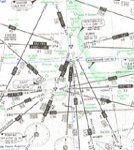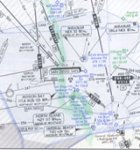Flying Our Route
How are the pilots flying our route? Your aircraft has finally leveled off at the requested flight level (FL) that was sent to air traffic control (ATC) earlier in our preflight phase by flight planning (flight dispatcher). As described in Flight Plan, the Captain has obtained and reviewed the travel route to your destination in the flight plan.
These air routes, or airways, were laid out years ago and are defined by electronic ground navigational aids. The VOR (VHF Omni-directional Range) stations emit continuous signals that aircraft can tune in on a particular frequency. Directional and distance information is received from these stations that are 200 to 300 miles apart. The routes that are in the low altitude route structure (below 18,000 feet) are designated by a number preceded by the letter "V" . Routes in the high altitude route structure (above 18,000 feet) are designated by a number preceded by the letter "J". These airways are laid out across the United States and the world.
In the early years, when commercial air travel was beginning and these airways were either nonexistent or not very reliable, the rule was to keep a very wary eye out for the other guy. Influenced by the "keep right" rules of the road used at sea, aircraft always kept right in the airways. For ease of visibility, the Captain chose to sit on the left to watch incoming traffic. That is why tradition has evolved that the Captain sits in the left seat.



High Altitude Routes
Low Altitude Routes
VOR Ground Station
Flying Our Route back to My Airline Flight